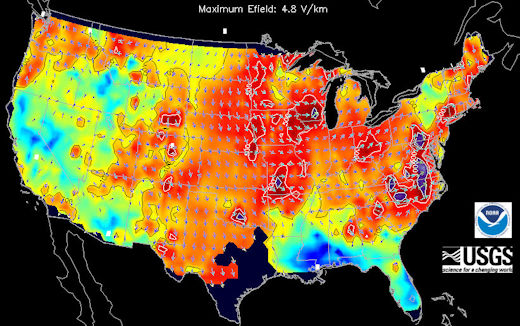Originally published at: https://peakprosperity.com/daily-digest/solar-flares-rock-global-networks-expose-grid-vulnerability/
In a series of events that underscore the fragility of our modern technological infrastructure, a barrage of solar activity has left its mark on Earth’s technological and energy systems. The initial shockwave from the sun, striking earlier than anticipated, brought about a geomagnetic storm that reached level four intensity. This rapid onset of solar-induced disturbances caused widespread disruptions across various networks and systems, highlighting the immediate effects of solar flares and coronal mass ejections (CMEs) on our planet’s magnetic field. The impact was felt globally, with reports of significant outages and technological issues, ranging from major online services like Amazon Web Services and Target’s website to social media platforms such as Pinterest and Snapchat facing operational challenges.
Further complicating the situation, a massive sunspot, AR3664, unleashed an X3.98 flare, marking it as one of the most potent flares of the current solar cycle. This particular solar flare led to the temporary or complete loss of high-frequency radio signals across vast regions, including Asia, eastern Europe, and eastern Africa. Such solar flares and accompanying CMEs are not just spectacular celestial events but also serve as a reminder of the sun’s potential to disrupt Earth’s technological backbone. As we approach the solar maximum, the peak of solar activity in the sun’s 11-year cycle, the importance of monitoring and preparing for these solar events becomes increasingly apparent.
Amid these natural phenomena, the vulnerability of the American power grid to various threats has been brought into sharp focus. The grid’s susceptibility to cyber attacks, electromagnetic pulses (EMPs), and geomagnetic disturbances (GMDs) is a growing concern. Despite the clear and present danger posed by these threats, there appears to be a lack of decisive action from both the government and the electric utility industry to fortify the grid against potential disruptions. Initiatives in cities like San Antonio and Rock Hill, which aim to protect the grid through retrofitting substations and implementing EMP mitigation measures, stand as beacons of proactive effort. However, the broader call to action involves not just industry insiders but the general public as well, urging them to contact legislators, spread awareness, and advocate for comprehensive grid security measures.
As the world grapples with the immediate challenges posed by solar activity, the underlying issues of grid vulnerability and the need for robust protective measures against a spectrum of threats remain pressing. The intersection of natural solar phenomena and human-made infrastructure vulnerabilities highlights a critical area of concern for both policymakers and the public. The ongoing situation serves as a stark reminder of our dependence on technology and the importance of safeguarding our electrical and technological infrastructure against the unpredictable forces of nature and human-originated threats.
Sources
Massive Solar Flares Cause Widespread Network and System Outages
There are literally dozens of regional network and system outages.
Source | Submitted by Friedrichs_teeth
First Solar Impact Hits Earth’s Magnetic Field Earlier Than Expected
The magnetic disruption to Earth came on much more quickly than anyone anticipated, and that includes me.
Source | Submitted by BeeFarmer
Colossal Sunspot Unleashes Largest Solar Flare Yet, Earth in Firing Line
The X3.98 flare peaked in the early hours this morning (May 10) at 2:54 a.m. (0654 GMT) triggering either temporary or complete loss of high frequency (HF) radio signals across Asia, eastern Europe and eastern Africa.
Source | Submitted by drsharp
America’s Power Grid: Vulnerable to Terrorism, Cyber Attacks, and Natural Disasters
The attack was the most significant incident of domestic terrorism involving the grid that has ever occurred in the US. This will be the next 9/11. This will be the next Pearl Harbor. As many as 90% of Americans could die. It could literally end civilization as we know it.
Source | Submitted by Robert B.

